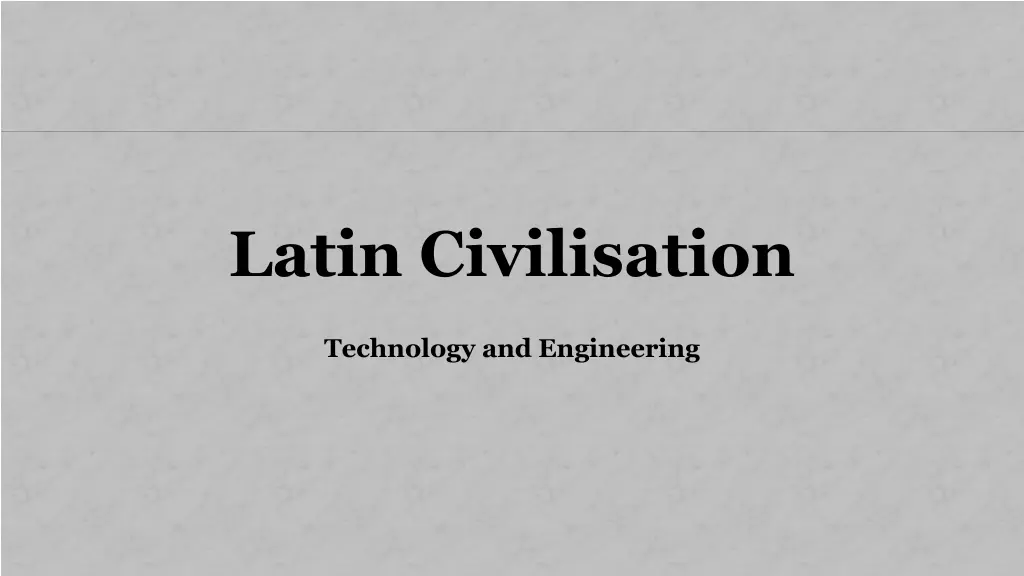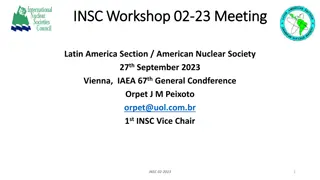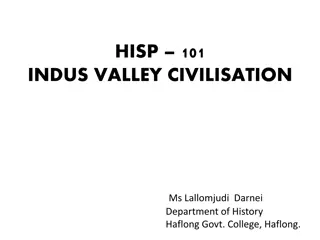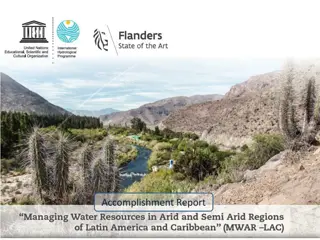
Engineering in Ancient Roman Civilization: Technology, Innovation, and Expertise
Explore the significance of engineering in ancient Roman civilization, where engineers possessed a diverse skill set and practical knowledge across various disciplines. Discover the unique approach to technology and engineering in Roman times, including the emphasis on practical problem-solving and the role of natural philosophers. Uncover the origins of engineering terminology and the evolution of technology from ancient to modern times.
Download Presentation

Please find below an Image/Link to download the presentation.
The content on the website is provided AS IS for your information and personal use only. It may not be sold, licensed, or shared on other websites without obtaining consent from the author. If you encounter any issues during the download, it is possible that the publisher has removed the file from their server.
You are allowed to download the files provided on this website for personal or commercial use, subject to the condition that they are used lawfully. All files are the property of their respective owners.
The content on the website is provided AS IS for your information and personal use only. It may not be sold, licensed, or shared on other websites without obtaining consent from the author.
E N D
Presentation Transcript
Latin Civilisation Technology and Engineering
The Importance of Engineering for the Romans The skill set of an engineer consists of familiarity with a number of disciplines and education in a variety of fields. His judgment puts to the test all work executed in the other fields of technology. This set of skills is the combined result of practice and theory. . . . Those who are thoroughly trained in both, equipped with a comprehensive tool set, execute a proposed plan with expertise and in a timely fashion. . . . Such a person must be educated in the liberal arts, skilled with a pencil, trained in land surveying, well versed in history, have diligently studied philosophy, appreciate understanding of medicine, be familiar with legal argumentation, and have knowledge of astronomy and celestial mechanics. Vitruvius, On Architecture, I, 1-3 music, should have some
The Importance of Engineering for the Romans Modern investigation mathematical principles. In the Roman period, the situation was quite different. In fact, the study and explanation of natural phenomena was a ge ntleman's ocupation. These individuals, whom we call natural philosophers, employed reason rather than experiment in their study of the natural world. The practical application and technical mastery of physical principles were left to skilled craftspeople, who derived their expertise from personal experience and probably from technical manuals that must have been in circulation among professionals in the same field. engineers develop application technology based scientific on the and and of
The Importance of Engineering for the Romans Another difference between ancient technology and modern engineering is the sense of immediacy. Sources of motive energy were, with a few significant exceptions, human or animal. The strength of hands and feet was directed or magnified by the pulley, lever, and inclined plane, but there was no possibility of accelerating locomotion on land beyond the speed of horses, donkeys, oxen, or camels. Moreover, Roman technology was purposeful and pragmatic. Its goal was to solve specific problems and respond to precise and immediate needs, not to earn money by its widespread dissemination and sale.
Some Terminology The word technology is ultimately derived from the Greek word techne ( skill, or craft ). The closest Latin equivalent, ars, is the root of the word artifex (artificer; a professional workman, craftsman, or artisan). Artifex and faber ( a worker in wood, stone, or metal ) perhaps come closest to the meaning of the modern English word engineer, itself derived from the Latin ingenium ( skill ; cleverness ; "talent"). A person who is ingeniosus is full of intellect and superior in mind. The word is also related to the Latin verb ingignere ( to beget ).
Some Terminology Another term that Roman authors use to denote a person responsible for the design and construction of buildings and mechanical contrivances, architectus, is derived from the Greek architekton ( chief artificer ). The word can be translated, depending on context, as both architect and engineer. The word machine is derived from the Latin machina, which is related to the Greek mechane (compare mechanics), meaning an artificial device for performing a task.
Borrowing and Transferring Knowledge As the Roman territory included more geographical areas that were different from central Italy, it was .natural that the Romans employed the local traditional technologies and skills to modify the environment according to their own needs. The propagation of this technological movement occurred, broadly speaking, from east to west. The Romans were introduced to the millennia-old cultures of Greece, Egypt, and Mesopotamia, adopted and adapted their technical know-how, and applied it to promote the development of cities in the largely non- urbanized societies in the west and north (Gaul, Spain, Germany, Britain). The urbanization of these geographical areas is one of the most lasting consequences of Roman technical and administrative influence, as many modern cities in Northern and Western Europe were originally founded by the Romans.
Concrete Concrete was invented in the late third century BCE. The development of this material, which could be shaped into any desirable form and (once hardened) was as durable as stone, revolutionized building construction and hard landscape architecture. Its use in Roman buildings disproves the general, erroneous idea that the Romans were not technological innovators. Walls were built with a core of cement mixed with an aggregate of small stones, called opus caementicium.
Concrete Wall facing was initially made of irregularly shaped stone blocks. The uneven appearance of the surface pattern led to the Latin term opus incertum.
Concrete During the late Republic, square blocks of regular size were used in a pattern that was reminiscent of a diagonal net covering, giving this new type the label opus reticulatum.
Concrete During the early Empire a facing of fired brick, called opus testaceum, became common, speeding up the construction process and further reducing cost. These walls consisted of a shell of two parallel brick walls, with the space between them filled with mortared rubble. Skilled craftsmen no longer had to chip stones into regular shapes. Instead, bricks could be easily shaped from clay and fired in mass production by unskilled workers.
Streets and Bridges The Roman road network was so well laid out that, in many instances, modern European ancient Roman roads. Its primary purpose was the fast and efficient movement of infantry, but the Roman public road network that spanned some throughout the empire was, of course, also used by civilian travellers. highways follow the 120,000 kilometres
Streets and Bridges The first major Roman road was the Via Appia, or Appian Way. Named after Appius Claudius Caecus, during whose censorship it was constructed, the road was built in 312 BCE between Rome and Capua (196 kilometres) to expedite the deployment of legionaries to central Italy. As Rome got involved in military affairs in the Hellenistic kingdoms of the eastern Mediterranean in the second half of the third century BCE, it was extended to reach the port town of Brindisi (for a total length of 569 kilometres).
Streets and Bridges During subsequent centuries well- developed roads were built in all Roman provinces, from Britain to Africa and from Spain to Mesopotamia. With regular rest stations and milestones showing the distance to major points along the route, the Roman highways had all the amenities that make long- distance travel as convenient as possible. In that respect, the roads were symbols of Roman technical skill and, especially in newly conquered regions, metaphors for Roman culture as a whole: stable, durable, and convenient. They were also a reminder that, should the need arise, the army had a means of access to any particular area.
Streets and Bridges Bridges were another important part of the road network. Engineers of the Roman army could build temporary (or collapsible) bridges and pontoon bridges. An example, built across the Danube on campaign in 104 CE, is depicted on Trajans Column. The earliest structures were made of wood, but Roman mastery of arch construction enabled architects to design stone bridges so durable that some of them remained in use for centuries.
Water Transport Traders made use of these roads as well, but land transport was generally slow and expensive, so most goods were transported by ship. Furthermore, the axles and frames of chariots and carts usually had no springs, so clattering along on a road paved with stone slabs would have been uncomfortable even over short distances.
Water Transport Unlike the Greeks, the Romans were never avid seafarers. The Italian peninsula is long and narrow, with only the Apennine Mountains forming a ridge that runs lengthwise roughly down the centre. Consequently, communication over land was relatively easy. The Romans, then, did not contribute much to naval technology, but they did use and adapt the maritime knowledge of other cultures.
Water Transport Polybius, 1, 20: "For when the Romans first took in hand the sending over of troops to Messene (in Sicily), not only did they not have decked ships, but no large vessels at all, not even a single galley. They made use of quinqueremes and triremes from Tarentum and Locris, and even from Elea and Neapolis, on which they audaciously carried men across. At this time, the Carthaginians had put to sea against them in the Strait of Messina. One of their decked ships, in their eagerness, ran aground. The wreck thus fell into the hands of the Romans, who used it as a template on which they modelled the construction of their entire fleet. Had it not been for this accident, it is clear that, due to their inexperience, they would not have been able to carry out their plans."
Water Transport Sea transport was on the transport of goods. much less expensive than land transport in antiquity. A cargo ship could carry many times the load of an ox cart. On the other hand, seafaring on the Mediterranean Sea could be archaeological evidence of shipwrecks is abundant. Seafaring was usually limited to the summer months (April to October) to avoid winter storms. Moreover, navigation was very difficult in the absence of the magnetic compass. Mariners navigated by prominent landmarks and the sun during the daytime and by the stars during the night. In good weather conditions, much of the land and islands in the area were visible. treacherous. Literary and
Water Transport Advantages: Staying within sight of land was expedient for a number of reasons. There was no great need for provisions as the crew could make landfall during the night and have access to shelter, food, and water a necessity for warships, whose narrow hulls usually did not have sufficient room for such items. In the event of a wreck, salvation was relatively close. Disadvantages: The rocks and cliffs of the jagged coastline of certain places, such as southern Turkey or the eastern Adriatic Sea, increased the risk of shipwrecks, and the coves and inlets of the same stretches of coast were ideal hideouts for pirates.






















